
Pages in this Folder:

Related Folders:
See also Department Site Map
This website was developed in 2001 thanks to a grant from the Toronto Parks and Trees Foundation.
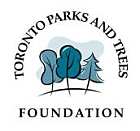
Notice: This web site is an information post and a forum for the community that uses the park, and to some degree for the surrounding neighbourhood. The editor of the web site reserves the right to post parts or all of any letters sent to the web site. If you do not want your letter posted, please let us know when you e-mail us, and we won't post it.
Comments?
For the basics, see
- Website & Privacy Policies
- How To Get Involved
- The Role of the Park
Search options:
Department Site Map
Custodians:
Indigenous Medicine Gardens, 2021 - 2025
2021
May 2, 2021
After a May 1-2 24-hour sacred fire held at the Dufferin Grove Park main fire circle, the idea of youth growing the sacred herbs at the park was raised. Community Garden coordinator Skylar said she'd be very pleased to make one of the city's new raised planters available right away. Instead, on May 2, Kailee C. started a GoFundMe campaign:
Kailee C is organizing this fundraiser. Medical, Illness & Healing
Help Us Grow Our Traditional Medicines at Dufferin
$3,121 raised of $3,000 goalA group of Indigenous youth in Toronto will be growing our four sacred medicines - tobacco, sage, cedar and sweetgrass - which are integrated into our peoples everyday lives and used in ceremonies to aid in offering, healing and protection.
Donations will be able to assist us as we plant, grow and harvest each medicine at Dufferin Grove park. Our goal is to keep our medicine readily accessible to the community, in an area that we hold many of our sacred ceremonies. We believe that being able to grow our medicines will help us to connect more with our community and give youth an opportunity to learn through our Elders, Healers and Medicine people.
Chi-miigwetch!
2022
May - early June
So far this season there seems to be very little gardening happening at the Indigenous plots. Two weeks ago one of the Indigenous campers from last year's sacred fire circle came by to tell Skylar that she had heard that the youth had established as different medicine garden near the Humber River, and wouldn't be coming back. She said she'd like to take over both plots, but this time with an emphasis on growing food for the people in the tents.
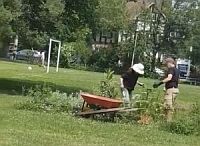
caught on camera
June 12, 2022
The camper who wants to take over the two gardens hasn't been around at all. Maybe she'll still come back, but in the meantime it seems a shame to lose all the plants. Sklyar and another coop volunteer dug up some of the daisies and one of the silver sage plants, and replanted them in the circle garden.
June 13, 2022
email from The Plant Life Tkaronto to Skylar
"There was a community member passing by on Sunday and saw you and another person removing plants and removing a Prairie Sage plug from our community garden....."
2023
No new work was done this year. Some links to Indigenous urban garden/farm groups and reports:
April 11, 2023
Report: Tkaronto is a Place for Sustenance:
Kaitlin Rizarri: "A collaboration between Ethan Dankert-Lannigan, Cheyanne Valencia-Hinds, Kikiyah Alina, Kailee Cripton-Eser and myself, Tkaronto Plant Life was founded as a small grassroots initiative. As emphasized in the Yellowhead Report on Indigenous Food Sovereignty in Ontario, food is a spiritual meeting point. After the 215 unmarked graves of Indigenous children were found at Kamloops Residential School, growing food together provided healing and connection for urban Black, Indigenous, and people of colour (BIPOC) at Dufferin Grove Park, a place where they often gathered during the summer of 2021. Food and medicines were made accessible to everyone, and as their relations grew, so did the plants. All were encouraged to help the garden thrive, especially those living in the park......As food insecurity amongst Black and Indigenous households remains the highest in the province – a contemporary result of centuries of colonization, slavery, and violence – BIPOC farmers, including Tkaronto Plant Life, refuse to let our communities go hungry and refuse to let urban communities be left out of food sovereignty and farming skills-building (Tarasuk et al., 2022). In fact, provinces (governments and people) can learn from Indigenous farmers and food systems if we are to build life-affirming, equitable, and ecologically-sound food systems for the future."
Also: Ojiiikaan: "Ojibiikaan was founded in 2018 to address gaps in Toronto related to Indigenous food sovereignty, such as food and nutrition education, sustainable food systems and practices, and traditional ecological knowledge. Ojibiikaan provides opportunities to engage with the land across the City to Toronto and the outer city."
Also: Toronto Urban Growers has a page called Indigenous gardens and organizations A lot of links but many are broken or don't go beyond 2022/2023.
2024
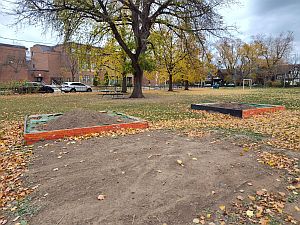
November 2024: all plants removed, and tarps put on
November 2024: A different (?) group came and removed all the plants in the Teaching Garden, and put tarps over the dirt.
2025
July 2025: No new work was done this year, so both Indigenous Garden boxes are once again filled with many wild plants, plus some of the original medicinal plantings, mostly growing at the margins or just outside the boxes.
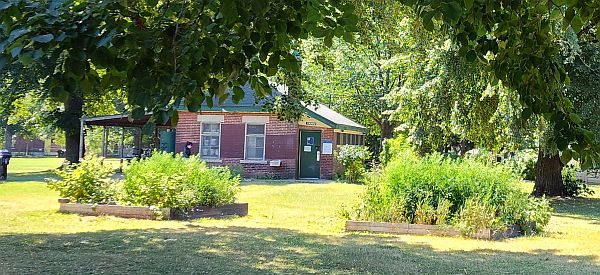
July 23, 2025
The plants have grown right through the tarps. These beds have become a rich source of information about the relationship between reintroduced native species and volunteer wild food/medicine plants at Dufferin Grove park.
Did the Indigenous Garden plants "invite" the non-native wild plants in? Can they coexist, with a bit of garden work?
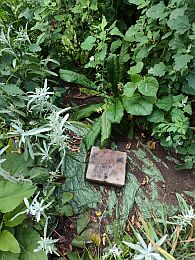
sage and tobacco: at the edge of the box
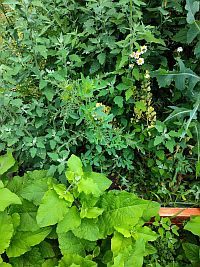
a mix of non-native plants inside the boxes

Hoary alyssum
Some of the volunteer plants that came to the Teaching Garden on their own:
- burdock - "gobo" food plant in Asia, pollinator, inspiration for velcro
common thistle -- (an important pollinator)
shepherd's purse -- cultivated as a commercial food crop in Asia
lamb's quarters -- used as a food plant worldwide; amaranth family and related to quinoa
- sow thistle edible and medicinal plant, not related to the common thistle
- vetch -- under cultivation for at least 9,500 years, contributes to soil fertility as other legumes do
-hoary alyssum -- all over the ground right outside the boxes. Non-native and popisonous for horses, but not for people.


 Printer friendly version
Printer friendly version